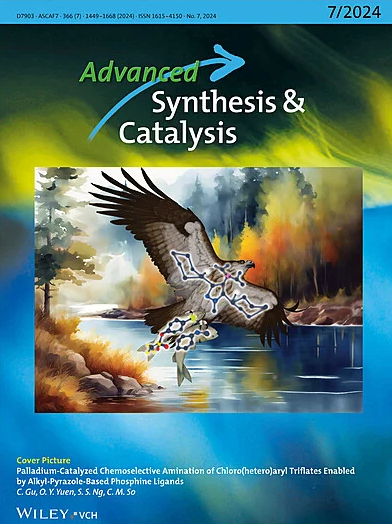轴向-点手性转移:铬(VI)催化2 -萘酚羟基脱芳化
IF 4
2区 化学
Q2 CHEMISTRY, APPLIED
引用次数: 0
摘要
轴向点的手性转移是构建手性中心的重要策略,其中轴向手性试剂大多局限于atropomerically stable。在这项工作中,提出了一个Cr(VI)催化的轴向手性2 -萘酚的对映选择性羟基脱芳(通过轴向点手性转移)。这种转化在广泛的轴向手性2 -萘酚中有效地进行,以高收率(高达85%)产生羟基脱芳产物,具有优异的对映选择性(高达99% ee)和对映特异性(高达99% es)。本文章由计算机程序翻译,如有差异,请以英文原文为准。
Axial‐to‐Point Chirality Transfer: Chromium(VI)‐Catalyzed Hydroxylative Dearomatization of 2‐Naphthols
Axial‐to‐point chirality transfer is an important strategy for the construction of chiral centers, where the axial chiral reagents are mostly limited to atropomerically stable ones. In this work, a Cr(VI)‐catalyzed enantioselective hydroxylative dearomatization (via axial‐to‐point chirality transfer) of axially chiral 2‐naphthols is presented. This transformation proceeds efficiently across a broad range of axially chiral 2‐naphthols, yielding hydroxylative dearomatized products in good yields (up to 85%) with excellent enantioselectivities (up to > 99% ee) and enantiospecificity (up to > 99% es).
求助全文
通过发布文献求助,成功后即可免费获取论文全文。
去求助
来源期刊

Advanced Synthesis & Catalysis
化学-应用化学
CiteScore
9.40
自引率
7.40%
发文量
447
审稿时长
1.8 months
期刊介绍:
Advanced Synthesis & Catalysis (ASC) is the leading primary journal in organic, organometallic, and applied chemistry.
The high impact of ASC can be attributed to the unique focus of the journal, which publishes exciting new results from academic and industrial labs on efficient, practical, and environmentally friendly organic synthesis. While homogeneous, heterogeneous, organic, and enzyme catalysis are key technologies to achieve green synthesis, significant contributions to the same goal by synthesis design, reaction techniques, flow chemistry, and continuous processing, multiphase catalysis, green solvents, catalyst immobilization, and recycling, separation science, and process development are also featured in ASC. The Aims and Scope can be found in the Notice to Authors or on the first page of the table of contents in every issue.
 求助内容:
求助内容: 应助结果提醒方式:
应助结果提醒方式:


